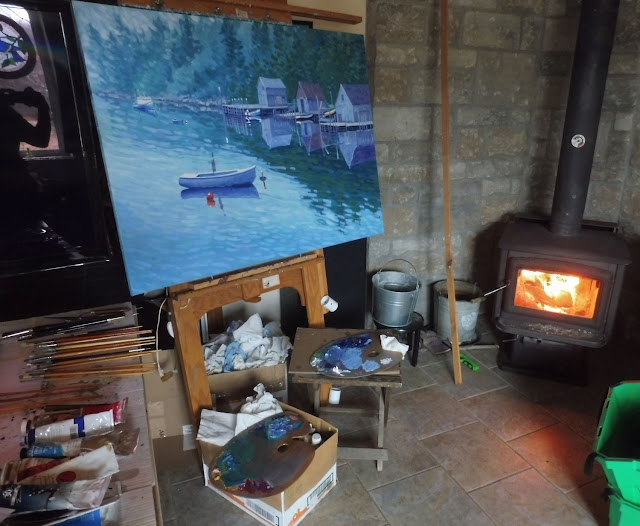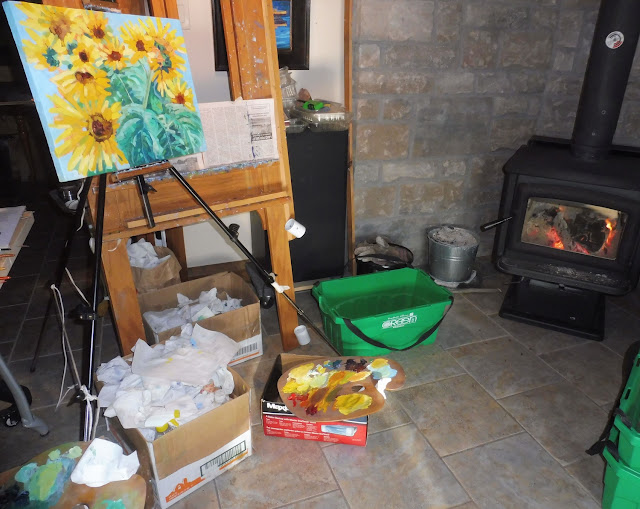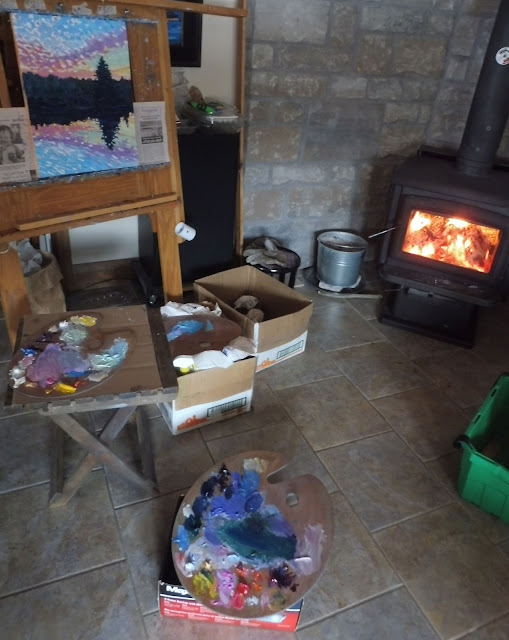 |
| #2940 "Light Yellow Tulips" 20x16 inches oils on stretched canvas Started Monday, March 31st, 2025 |
I had to walk away from #2939 "March Weather at Singleton". I was in danger of fine-tuning the oils too much - killing the life in a painting with a thousand strokes. Unfocused fiddling can ruin the music. The best way to move on is to simply pick another subject and a different canvas.
Our kind friends at the Rideau Lake Library had given Linda a retirement party. Linda called it her "tiny job," but it was much more than that. Linda has a rare skill set that she freely shares. Those flowers were a gift from her friends. They were displayed on the kitchen island, and I quite enjoyed them and their aroma. The "light yellow tulips" according to the florist tag, were well past prime by the time I was looking for something else to paint on a wintry morning. I thought they were still pretty and deserved a canvas.
I was very careful during the transport of the flowers to the Singleton Studio, but at least six petals fell off on the way. There was no point attempting to stick them back on! I decided I had better get painting before they all dropped off.
 |
| My natural habitat during the cold winter days with wind chill. |
At first, I placed the 20x16 stretched canvas on the studio easel that my Dad built. I could not get the light right to suit me. Instead, I employed one of my field easels and that worked just fine. I charged right into the oils, standing in front of the wood stove. There was quite a lot of expensive oil paint on my palette, and I did not want to waste it. The effort was fun.
The weather on Monday was dominated by rain showers and another cold front. Plein air would have been a bit unpleasant. The entire week was marked by a series of spring storms. Those conditions kept me in the Studio playing with this canvas.
On the third day of playing with these tulips (Wednesday morning and my birthday), I went into the Studio to discover many more of the tulip petals on the table. I had taken some "just in case" photos of the flowers, so all was not completely lost. That is also when I saw the shadow of the Easter bunny on the table. From then on, I decided to really let my short hair down with this canvas and have some serious fun.
Two rather nasty freezing rain events were the result of a split flow in the atmosphere. A weakening and meandering jet stream is the direct result of global warming. The impacts of the freezing rain storm were devastating to many... We sadly lost some trees in the Singleton forest.
 |
| Lots of interesting colours on the two palettes... |
The ice storm damage was even more severe in lower Michigan, with an estimated 3 million acres of forest devastated. Two weeks after the event, 10,000 households were still without power. The impacts of the ice storm would affect the state for "40-50 years" according to Lucas Merrick of the Michigan Department of Natural Resources. See https://www.accuweather.com/en/winter-weather/millions-of-trees-snapped-in-half-over-10000-without-power-weeks-after-michigan-ice-storm/1765711.
The fact of global warming is undeniable as the planet enters thousands of years of a "super interglacial period". The following summarizes the state of global warming in 2024.
The dramatic 2024 jump in atmospheric CO2 (the red oval to the right in the following graphic) is not the result of human activities, which have been steady at pumping 40 billion tons of CO2 per year. That leap reveals the dramatic decline of the natural carbon sinks of terrestrial ecosystems and oceans to absorb as much CO2 as in the past. Continued warming will further limit the natural absorption of atmospheric CO2.
The Holocene Epoch began 11,700 years ago at the end of the last glacial period. It is about to get much hotter.
For this and much more art, click on Pixels or go straight to the Collections. Here is the new Wet Paint 2024 Collection.
Warmest regards and keep your paddle in the water,












































